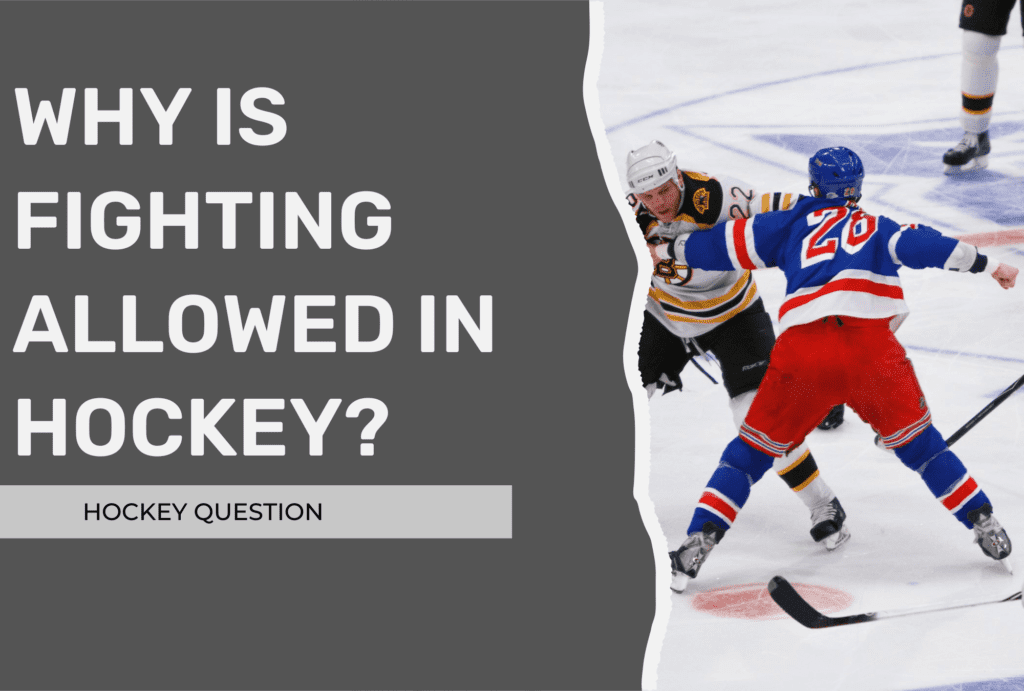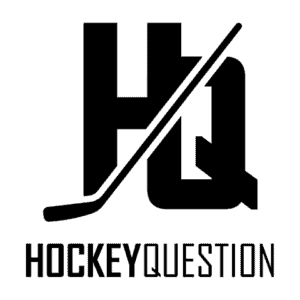Have you ever watched a game of football, baseball, or basketball and seen a fight break out?
It’s a pretty shocking experience which usually ends in players being ejected from the game.
However… When you’re watching professional hockey, fighting is the norm.
The National Hockey League (NHL) is the only major professional sport league that allows fighting as a part of the game.
But… There are consequences.
In this article, you’ll learn exactly why fighting is allowed in ice hockey even though it’s banned in other sports.
Let’s begin.
Here’s Why Fighting Is Allowed in Hockey:
“Fisticuffs” is an official part of hockey due to NHL Rule 46. Fighting allows the sport to “police itself” and may prevent injuries.

Do They Still Allow Fighting in Hockey?
Yes, fighting is still allowed in hockey today.
According to rule 46 in the NHL Rule Book:
“A fight shall be deemed to have occurred when at least one player punches or attempts to punch an opponent repeatedly or when two players wrestle in such a manner as to make it difficult for the Linesmen to intervene and separate the combatants.
The Referees are provided very wide latitude in the penalties with which they may impose under this rule. This is done intentionally to enable them to differentiate between the obvious degrees of responsibility of the participants either for starting the fight or persisting in continuing the fight. The discretion provided should be exercised realistically.”
It’s important to note: Fighting is NOT allowed in any league other than the National Hockey League (NHL). Minor hockey and youth hockey programs do not allow any form of fighting.
If players are caught fighting in any non-NHL hockey leagues, there will be serious consequences including being ejected from the game and possibly suspension.
Why Is Fighting Allowed in Hockey But Not Other Sports?
You may be wondering… why do they let fighting happen in hockey but you don’t see it in any other sport like basketball, football, or baseball?
That’s a great question!
Before diving in, it’s important to keep in mind that fighting is only allowed in the NHL. There aren’t any other leagues in the world that allow it.
Let’s back up a bit.
During the early years of the National Hockey League (1950s-1960s), there were only 6 NHL teams.
Each team played 70 games per season. This meant that each team would have played every other team about 14 times every year. Then, they’d play another team up to 7 times.
That meant you could face the same opponent 21 times in a 6 month period.
Back in those days, there was a single official in charge of refereeing the game.
There were no helmets. There were no face masks. The “Original 6” era It was a much more brutal and aggressive game than it is today.
Players would be assaulting other players on the ice with their fists, elbows, and even sticks with little regulation. Combine that level of aggression with the sheer volume that you’d see the same guys over and over again, and you can bet things got heated during the games.
There had to be some level of regulating all that aggression, emotion, cheap shots, and targeted attacks beyond what the official could offer.
That’s where fighting came into the league. It’s all about easing that aggression, and even more importantly, protecting yourself and the superstars on your team.
It’s a way that you can stabilize your opponents’ aggressive behavior.
You’ve got to remember that this is the fastest team sport on earth. There’s major contact happening throughout the game. Hockey has a certain level of intensity that just isn’t seen in football, basketball, baseball, or soccer.
If there’s any sport that “needs” this type of regulation, it’s hockey.
However, that doesn’t mean it’ll stay forever. With every decade that passes in the NHL, we see tighter and tighter regulations and consequences for aggressive behavior.
The league is cracking down on head shots. They’re taking concussions much more seriously now than they did back in the 90s. While fighting is still legal today in hockey, there’s a chance it won’t be there for long.
Why Are There So Many Fights in Hockey?
Have you ever wondered why there are so many fights in the game of hockey?
Well, simply put, it’s all about teammates sticking up for one another.
When your top scorer is targeted by the other team… And they’re coming after him every game to intentionally harm him, then something has to be done to stop it.
That’s where enforcers come in. They’re enforcing protection over their stars.
Wayne Gretzky wasn’t a big guy. He didn’t get in fights or hit much.
He was small, fast, and skilled.
And players would come after him because he was so dominant on the ice.
But… Gretzky likely wouldn’t have the records he has today without tough teammates like Marty McSorley.
When McSorley and others began standing up for Gretzky by fighting, people stopped coming after Gretzky as much.
The same holds true today, though the league is taking fighting more seriously today than in the 80s and 90s.
Do Hockey Players Get Fined for Fighting?
In most cases, hockey players are not fined for fighting during an NHL hockey game.
While they aren’t generally fined for fighting, there are exceptions. If an NHL player is given an instigator penalty during the last five minutes of the game (either in regulation or overtime), the coach will be fined $10,000.
NHL hockey players can be fined for other violations. For instance, if the Department of Player Safety rules that a player intentionally harmed another player (in most cases with an illegal check), they may be given a fine and a suspension.
Curious to know more answers to the most common hockey questions? Be sure to check out our other popular blog posts: When Are Hockey Tickets Cheapest, What Hockey League Pays the Most, How Do Shifts Work in Hockey, and Is Ice Hockey Hard to Learn? (Plus How to Speed Up the Process)
Sources
https://www.nhl.com/info/video-rulebook
https://www.nhl.com/info/player-safety
https://www.businessinsider.com/fighting-nhl-hockey-violence-sports-code-referee-2017-2
